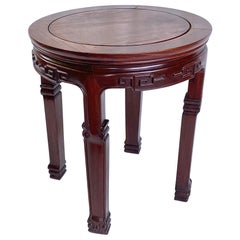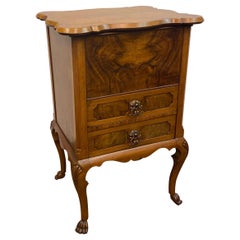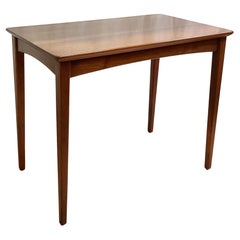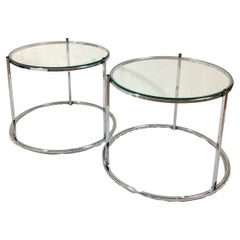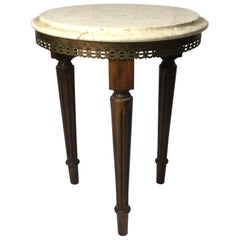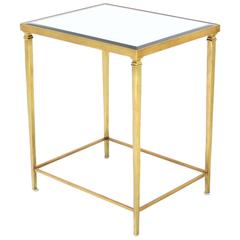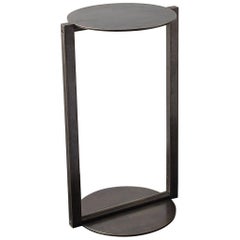A Touch of The Past Antiques End Tables
to
Height
to
Width
to
Depth
to
5
5
2
1
4
2
2
2
3
2
1
1
1
3
1
1
1
1
5
5
5
Chinese Solid Wood Low Round Side Table or Drink Table
Located in Lambertville, NJ
Chinese Solid Wood Low Round Side Table Drink Table. Nice solid round low extra table would be great for a large plant and/or your drink. 20 inche...
Category
Late 20th Century Chinese End Tables
Materials
Hardwood
Mid 19th Century Flame Walnut Sewing Table Cabinet
Located in Lambertville, NJ
Antique mid 19th Century flame walnut sewing or work table. The highly figurative wood top, that lifts up to reveal a sewing compartment lined in light ...
Category
Antique Mid-19th Century English End Tables
Materials
Walnut
Mid-Century Danish Modern Teak Side Table
Located in Lambertville, NJ
Mid-Century Danish Modern Teak Side Table marked only D74. Very clean and a great size. 20" tall by 25 by 14 1/2".
Category
Vintage 1950s Danish Mid-Century Modern End Tables
Materials
Teak
Pair Round Chrome and Glass Drink Side Tables
Located in Lambertville, NJ
Pair Round Chrome and glass drink side tables. These table are un-marked. Great size, only 18 1/2" by 15 1/2" tall.
Category
Late 20th Century Italian Mid-Century Modern End Tables
Materials
Chrome
Marble Top Drink Table Stand with Fluted Tapered Legs
Located in Lambertville, NJ
Wonderful little drink stand or plant stand with marble top. 14” in diameter and 18” tall. Dark brass trim above fluted tapered legs. Age appropria...
Category
Vintage 1950s American End Tables
Materials
Marble
Related Items
Solid Brass Tapered Leg Beveled Glass Mirror Top Side End Table
By Mastercraft
Located in Rockaway, NJ
Mid century modern elegant solid brass beveled mirror top side end table or stand.
Category
20th Century American Mid-Century Modern End Tables
Materials
Brass
Untitled Side Table 2.0 Blackened Brass Small Round Accent, End or Drink Tray
By Adam Otlewski
Located in Ozone Park, NY
Solid machined brass in matte blackened finish with recessed hex-head fasteners. The suspended lever design is a play on lightness and visual illusion in a solid metallic form. Petit...
Category
2010s American Bauhaus End Tables
Materials
Brass
$3,050 / item
H 20 in W 12 in D 10 in
Late 19th Century Spanish Walnut Side Table
Located in Miami, FL
Walnut side table from the 19th century from Spain with a plank top, around the chest of drawers a hand-carved decorated molded edge and a drawer with very old iron handles, on the s...
Category
Antique Late 19th Century Spanish Baroque Side Tables
Materials
Walnut
Handcrafted Modernist Side Drink Table
By SUM Furniture
Located in London, GB
Beautifully hand-turned and handcrafted English ash ripple side table in the modernist design. This is a bespoke piece of fine quality, handmade by master-craftsmen in solid English ...
Category
21st Century and Contemporary English Modern Side Tables
Materials
Ash
Untitled Side Table 2.0 Polished Brass Small Round Accent, End or Drink Tray
By Adam Otlewski
Located in Ozone Park, NY
Solid machined brass with recessed hex-head fasteners. The suspended lever design is a play on lightness and visual illusion in a solid metallic form. Petite sized to pull up next to...
Category
2010s American Bauhaus End Tables
Materials
Brass
$3,300 / item
H 20 in W 12 in D 10 in
Mid-Century Modern Sculptural Chrome and Glass Tubular Side Table
By Paul Tuttle, Strässle International
Located in Lambertville, NJ
Mid-Century Modern chrome and glass end or accent table featuring a sculptural tubular frame with a removable glass top.
Category
Vintage 1970s Mid-Century Modern Side Tables
Materials
Chrome
Solid Suar Wood Round Side Table Modern Organic
Located in Jimbaran, Bali
A wonderfully sculptural round side table. Its neutral pigments make it perfect for any space. A uniquely sculptural and versatile piece certain to invoke conversation. It was crafte...
Category
21st Century and Contemporary Indonesian Organic Modern Side Tables
Materials
Wood, Fruitwood
Untitled Side Table 2.0 Polished Nickel Small Round Accent, End or Drink Tray
By Adam Otlewski
Located in Ozone Park, NY
Solid machined brass in polished nickel plated finish with recessed hex-head fasteners. The suspended lever design is a play on lightness and visual illusion in a solid metallic form...
Category
2010s American Bauhaus End Tables
Materials
Brass
$3,695 / item
H 20 in W 12 in D 10 in
Solid Suar Wood Round Side Table Modern Organic
Located in Jimbaran, Bali
A wonderfully sculptural round side table, with an hourglass shape. Its neutral pigments make it perfect for any space. A uniquely sculptural and versatile piece certain to invoke co...
Category
21st Century and Contemporary Indonesian Organic Modern Side Tables
Materials
Wood, Fruitwood
Mid Century Modern Side Tables 1950s, End Tables
By Russel Wright
Located in Miami, FL
Great pair of end tables from the 1950s. Ready for a new home.
Category
Vintage 1950s American Mid-Century Modern End Tables
Materials
Wood, Plywood
19th Century French Louis XV Walnut Nightstand ~ End Table
Located in Dallas, TX
19th century French Louis XV walnut nightstand ~ end table is remarkable in that it's carved on all four sides with wonderful Rococo...
Category
Antique 1870s French Louis XV Night Stands
Materials
Walnut
Mid-19th Century Italian Side Table
Located in Round Top, TX
A charming mid-19th century side table from Northern Italy in painted wood. Fabulous finish and patina. A lovely shape with splayed legs, one drawer and centre shelf.
Category
Antique Mid-19th Century Italian Side Tables
Materials
Wood
